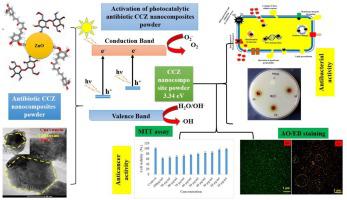Carbohydrate Polymers ( IF 11.2 ) Pub Date : 2020-07-30 , DOI: 10.1016/j.carbpol.2020.116825 Chandrasekaran Karthikeyan 1 , Kokkarachedu Varaprasad 2 , Ali Akbari-Fakhrabadi 3 , Abdulrahman Syedahamed Haja Hameed 4 , Rotimi Sadiku 5

|
As a result of the existence of drug-resistant bacteria and the attendant deficiency of innovative antibiotics, the therapeutic and the clinical sectors are, continually, in search of appropriate multifunctional nanomedicines. Herein, curcumin-chitosan-zinc oxide (CCZ) was successfully synthesized by a one-pot method. Transmission electron micrograph reveals that curcumin and chitosan were layered on a hexagonal ZnO and the particles are sized to ∼48 nm. X-ray diffractogram confirmed the formation of CCZ crystal structure. The photoluminescence spectra of CCZ, shows blue and green emissions at 499 nm and 519 nm, respectively, due to the active radicals generated in the nanomaterial, which are responsible for the associated antimicrobial and anticancer activities. The antibacterial activity of the CCZ, performed against methicillin-resistant Staphylococcus aureus (MRSA) and Escherichia coli (E. coli), showed a greater antibacterial effect than the commercial amoxicillin. The cytotoxic effect of the CCZ nanomaterial was examined in cultured (MCF-7) human breast cancer cells. An IC50 concentration value of 43.53 μg/mL, was recorded when evaluated after 24 h of CCZ with the MCF-7 cell line. From this study, it is believed that CCZ is a highly promising nanomaterial, which will be suitable for advanced clinical applications.
中文翻译:

通过一锅法制备生物分子壳聚糖,姜黄素和基于ZnO的抗菌纳米材料。
由于耐药细菌的存在和伴随性创新抗生素的缺乏,治疗和临床领域一直在寻找合适的多功能纳米药物。在此,通过一锅法成功地合成了姜黄素-壳聚糖-氧化锌(CCZ)。透射电子显微镜照片显示姜黄素和壳聚糖层积在六角形ZnO上,颗粒尺寸约为48纳米 X射线衍射图证实了CCZ晶体结构的形成。CCZ的光致发光光谱分别在499 nm和519 nm处显示蓝色和绿色发射,这归因于纳米材料中产生的活性自由基,这些自由基负责相关的抗微生物和抗癌活性。CCZ对耐甲氧西林的金黄色葡萄球菌(MRSA)和大肠杆菌(E. coli)的抗菌活性显示出比市售阿莫西林更大的抗菌作用。在培养的(MCF-7)人乳腺癌细胞中检查了CCZ纳米材料的细胞毒性作用。IC 50当使用MCF-7细胞系CCZ 24小时后评估时,记录的浓度值为43.53μg/ mL。从这项研究中,可以相信CCZ是一种很有前途的纳米材料,将适合于先进的临床应用。



























 京公网安备 11010802027423号
京公网安备 11010802027423号